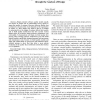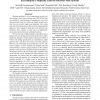19 search results - page 1 / 4 » Understanding Prediction Limits Through Unbiased Branches |
APCSAC
2006
IEEE
13 years 10 months ago
2006
IEEE
The majority of currently available branch predictors base their prediction accuracy on the previous k branch outcomes. Such predictors sustain high prediction accuracy but they do...
ISCA
2000
IEEE
13 years 9 months ago
2000
IEEE
For many applications, branch mispredictions and cache misses limit a processor’s performance to a level well below its peak instruction throughput. A small fraction of static i...
WCRE
2009
IEEE
13 years 11 months ago
2009
IEEE
—Object-oriented software quality models usually use metrics of classes and of relationships among classes to assess the quality of systems. However, software quality does not de...
JSA
2006
13 years 4 months ago
2006
It is often possible to greatly improve the performance of a hardware system via the use of predictive (speculative) techniques. For example, the performance of out-of-order micro...
ISCA
2003
IEEE
13 years 9 months ago
2003
IEEE
Meeting deadlines is a key requirement in safe realtime systems. Worst-case execution times (WCET) of tasks are needed for safe planning. Contemporary worst-case timing analysis t...


